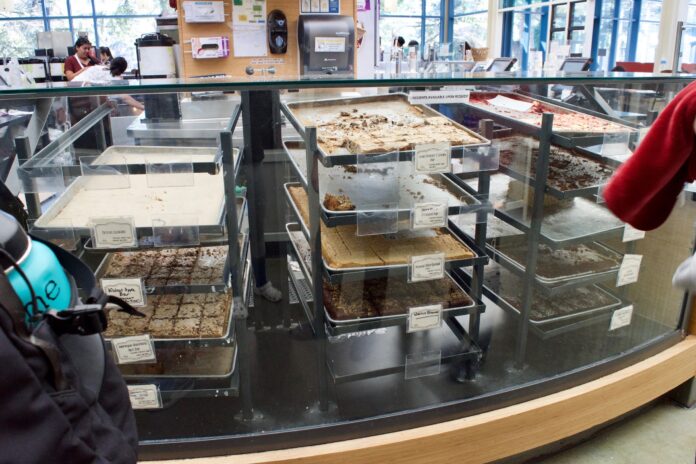Popular menu items including baked goods, burritos boast high calorie counts, while “Nourish” labels have potential to steer students toward healthier choices
Former ASUCD Senator Atanas Spasov recently took to Reddit to share a spreadsheet he found containing nutritional facts for all menu items offered at the UC Davis CoHo. This same sheet can be found on the CoHo website, yet it seems that not many students are aware of its presence.
Numerous individuals commented on Spasov’s post, thanking him and saying they were unaware of the information.
According to the U.S. Food and Drug Administration, young men and women should be consuming around 2,000 calories per day, depending on activity level. Broken down over the course of a day, that leaves roughly 500 calories per meal along with beverages and snacks for women and roughly more for men. Certain items offered by the CoHo clearly exceed these caloric recommendations.
Several CoHo favorites are among the most caloric choices on the menu: a basic breakfast burrito has 49 grams of fat and 993 calories — roughly half of the total daily calories needed for most individuals. Tofu Roja taco salads with rice contain 1,147 calories. Popular drink items like caramel espresso blasts, the CoHo’s version of a frappuccino, have 611 calories, 61 grams of sugar and 29 grams of fat.
The CoHo’s chicken caesar salad has 709 calories, 1,129 milligrams of sodium and 47 grams of fat. Another salad, recommended by the CoHo as a healthier choice, is the Chinese Chicken Salad, which contains 652 calories.
Debbie Fetter, a lecturer in the department of nutrition, and Anna Jones, an assistant project scientist in the department of nutrition with a research focus on nutrition education, recommended choosing lighter, oil-based dressings like vinaigrettes rather than creamy dressings that usually come with Caesar salads.
“There are many foods that people perceive as healthy when in reality they may not be as nutritious as they’re marketed to be,” Fetter said. “For example salads, such as caesar salads, are generally thought of as super healthy. However, just because it’s a salad doesn’t automatically mean it’s your best healthy option.”
Although the nutrition information has been available on the CoHo’s website for over a year, the information is presented on a Google Sheet and many students are unaware the document even exists.
“It is my hope that as students have access to this information, that they may dine at the CoHo and by extension make healthy choices when eating there,” Spasov said.
For many students, the accessibility of the CoHo’s drink and meal options make it a staple for them during the quarter. Students routinely flock to the CoHo during peak lunch time hours and passing periods for quick snacks or full meals.
“Much of our eating habits are a secondary thought to our academic and work commitments,” Spasov said. “Students shouldn’t have to unknowingly relegate themselves to calorie-rich, unhealthy options purely for the sake of saving time.”
Jones commented on the responsibility of UC Davis to help enable students to make healthier choices.
“While I understand profit motivation drives a lot of the decisions regarding what is offered on campus, I think that campus food vendors could make it easier for the healthy choice to be the default choice,” Jones said. “For a lot of students, college is their first experience being responsible for all their own grocery shopping and food choices, which means it’s a prime time to start establishing habits. Developing healthy habits during the college years can go a long way toward maintaining those habits for life.”
Darin Schluep, the food service director for Associated Students Dining Services including the CoHo, CoHo South Café and BioBrew, explained how management tries to find a medium between profit-making and providing a healthy menu variation.
“The Coffee House is always trying to balance the desire to be a student service (employing primarily students, student-friendly pricing, etc.) with being a business that must have a certain level of success to continue to operate and support its own internal stakeholders,” Schluep said via email. “I would say that ultimately it is our goal that the good things we do for the students, whether it’s providing nutritious menu options or making sustainable, environmentally-conscious choices when it comes to menu and packaging, end up leading to more folks coming to us when they need to grab a bite to eat or a quick cup of coffee before class.”
He also addressed the dining service’s focus on the campus-wide Nourish program. The initiative helps students identify items that meet “healthy” criteria established by campus nutritionists, he said.
“This process has helped us identify ways that we can adjust some recipes to help broaden our Nourish menu,” he said. “For example, we recently switched to a low-sodium base that helped qualify more of our items on the Cooks line for the Nourish label.”
“Nourish” items are highlighted on the nutrition facts sheet and are also labeled on the on-site menu boards. Some stations, such as Croutons, feature Nourish labels on more than half of their menu items, while others, such as Ciao Pizza, offer none.
Schluep commented on the possibility of increased visibility for the CoHo’s nutrition facts.
“Nutrition facts for all of our menu items are readily accessible via our website,” Schleup said via email. “We are considering moving to more digital menu boards, which would allow us to list more information in the platform areas, including possibly calorie counts as well as other dietary concerns (vegan, vegetarian, gluten-free, etc.).”
Written by: ALLY RUSSELL and CLAIRE DODD — campus@theaggie.org






Skip breakfast (not the most important meal of the day) and enjoy a 1000 calorie lunch. Problem solved.